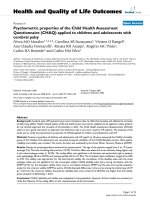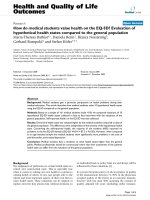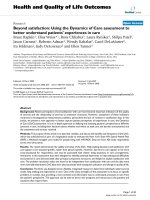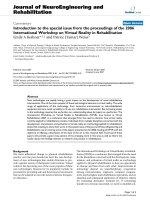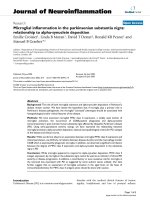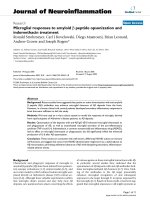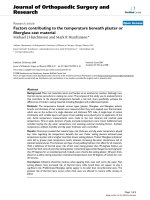Báo cáo hóa học: " Editorial Introduction to the Special Issue on Wireless Video" doc
Bạn đang xem bản rút gọn của tài liệu. Xem và tải ngay bản đầy đủ của tài liệu tại đây (421.06 KB, 2 trang )
Hindawi Publishing Corporation
EURASIP Journal on Advances in Signal Processing
Volume 2008, Article ID 749159, 2 pages
doi:10.1155/2008/749159
Editorial
Introduction to the Special Issue on Wireless Video
Fulvio Babich,
1
David R. Bull,
2
and Jianfei Cai
3
1
Dipartimento di Elettrotecnica, Elettronica ed Informatica, Universit
`
a degli Studi di Trieste, 34127 Trieste, Italy
2
Department of Electrical and Electronic Engineering, University of Br istol, Bristol BS8 1UB, UK
3
School of Computer Engineering, Nanyang Technological University, Singapore 639798
Correspondence should be addressed to Fulvio Babich,
Received 1 July 2008; Accepted 1 July 2008
Copyright © 2008 Fulvio Babich et al. This is an open access article distributed under the Creative Commons Attribution License,
which permits unrestricted use, distribution, and reproduction in any medium, provided the original work is properly cited.
Mobile communications, the Internet, and other emerging
consumer technologies continue to have a major impact on
our personal and business lives. Increasing numbers of media
centric devices now have integrated wireless functionalities,
and video-based services are becoming increasingly impor-
tant. However, longer-term adoption of wireless video will
hinge on a number of issues: the business model (does it
make money?), the content (do we want to watch it?), the
terminal capability (is the display bright enough and the
battery l ife long enough?) and, not least, accessibility and
visual quality (is it watchable?). This critical latter area is the
topic of this special issue.
Because of its large bandwidth requirements, coupled
with increased demand, video will become the dominant
and most critical form of traffic in and beyond 3G/4G
wireless systems. Reliable digital video transmission over
wireless connections is widely acknowledged as challenging,
given the hostile communication environment which is
characterised by unpredictable connection quality, variable
delay, sig nificant error rates, limited available bandwidth,
and severe energy constraints. These are compounded by the
very nature of video information which, when compressed,
is inherently sensitive to bit and packet losses.
When developing a reliable video transmission system
for operation over a wireless network, many varied and
interacting technical problems must be addressed, some of
which may be application or standard specific. Many of
these issues are addressed in the 12 papers contained in this
special issue. The papers broadly fit into three categories: (i)
error-resilient video and cross-layer optimisation, (ii) quality
assessment, and (iii) the impact of the wireless channel and
network. Due to the nature of the subject, however, several of
the papers cut across more than one category.
The first 5 papers deal with error-resilience and cross-
layer optimisation. The first paper by Pierre Ferr
´
eetal.
addresses the issue of cross-layer optimisation for enhanced
quality transmission over wireless LANs. A novel link adapta-
tion scheme is presented that improves the quality of service
(QoS). Rather than maximising the error-free throughput,
this minimises the video distortion of the received sequence
enabling the system to select the link speed which offers the
lowest distortion and to adapt to varying channel conditions.
The second paper by Hyungkeuk Lee et al. presents a cross-
layer approach to improve video quality in an MIMO system.
This is based on unequal error protection, where the coding
strength is dictated by visual importance. The paper by Zhu
Li et al. focuses on the issue of video transmission over a
severely impaired, bandwidth-limited channel, taking into
account battery life. The approach is based on the joint
optimisation of video summarisation, coding, modulation,
and packetisation, demonstrating substantial advantages
under these constraints.
Scalability is an important codec characteristic which
can be exploited to define new scheduling and prioritisa-
tion algorithms for the efficient delivery of time-sensitive
video traffic. The paper by Max Agueh et al. presents an
optimised FEC scheme which is JPEG2000 compliant and
which provides an important step towards providing QoS
guarantees in JPEG2000-based wireless multimedia systems.
Following this, the paper by Nicolas Tizon and B
´
eatrice
Pesquet-Popescu exploits the properties of H.264/SVC in
the context of a wireless network. Their approach combines
temporal and SNR scalability features with an intelligent
packet scheduling strategy to achieve substantial quality
gains over convention approaches.
The next two papers deal with the crucial issue of picture
quality. The contribution by Pasquale Pace and Emanuele
Viterbo proposes a method for assessing the perceived
quality of streaming media taking into account both loss
and bandwidth. Based on VQM, the approach correlates well
2 EURASIP Journal on Advances in Signal Processing
with subjective assessments and can offer real-time quality
assessment and adaptation. From a prac tical viewpoint,
the second paper by Heidi Himmanen et al. addresses the
assessment of video quality in the context of streaming DVB-
H services to mobile handhelds. Their results demonstrate
the shortcomings of existing approaches and help to lay the
foundations for future objective criteria.
The final five papers focus on specific aspects of the
wireless physical layer, MAC, or network and how these
impact video transmission. The first contribution by Alfonso
Fernandez Duran et al. deals specifically with low-latency
video services, addressing the impact of wireless handover on
latency. The paper demonstrates that improved performance
can be obtained through the use of alternative decision
thresholds. Julie Neckebroek et al. consider the merits of FEC
an ARQ in the context of a wireless Rayleigh fading link. They
analyse the diversity gain offered by FEC and ARQ in terms
of fading parameters, latency, and transmission overhead
and apply their results to the case of an indoor 60GHz
HDTV link. The paper by Chi-Huang Shih et al. introduces
a transparent loss recovery scheme based on a transparent
end-to-end QoS mechanism and an instantaneous frame-
level FEC allocation technique, which provides near optimal
performance with low delay. Rouzbeh Razavi et al. address
the issue of power constraints in a Bluetooth network. They
propose fuzzy logic as a means of controlling ARQ in the
context of packet delay deadlines and buffer management.
Finally, Saeid Montazeri et al. propose a new distributed QoS
(MAC scheduling) scheme for WLANs which is capable of
dealing with both CBR and VBR traffics in terms of delay
and throughput.
ACKNOWLEDGMENTS
The guest editors hope you enjoy this special issue and would
like to thank all the authors who have contributed to it. In
addition, special thanks go to all the reviewers who have
donated their valuable time to inform the decision process
and to provide construc tive feedback to the authors.
Fulvio Babich
David R. Bull
Jianfei Cai

